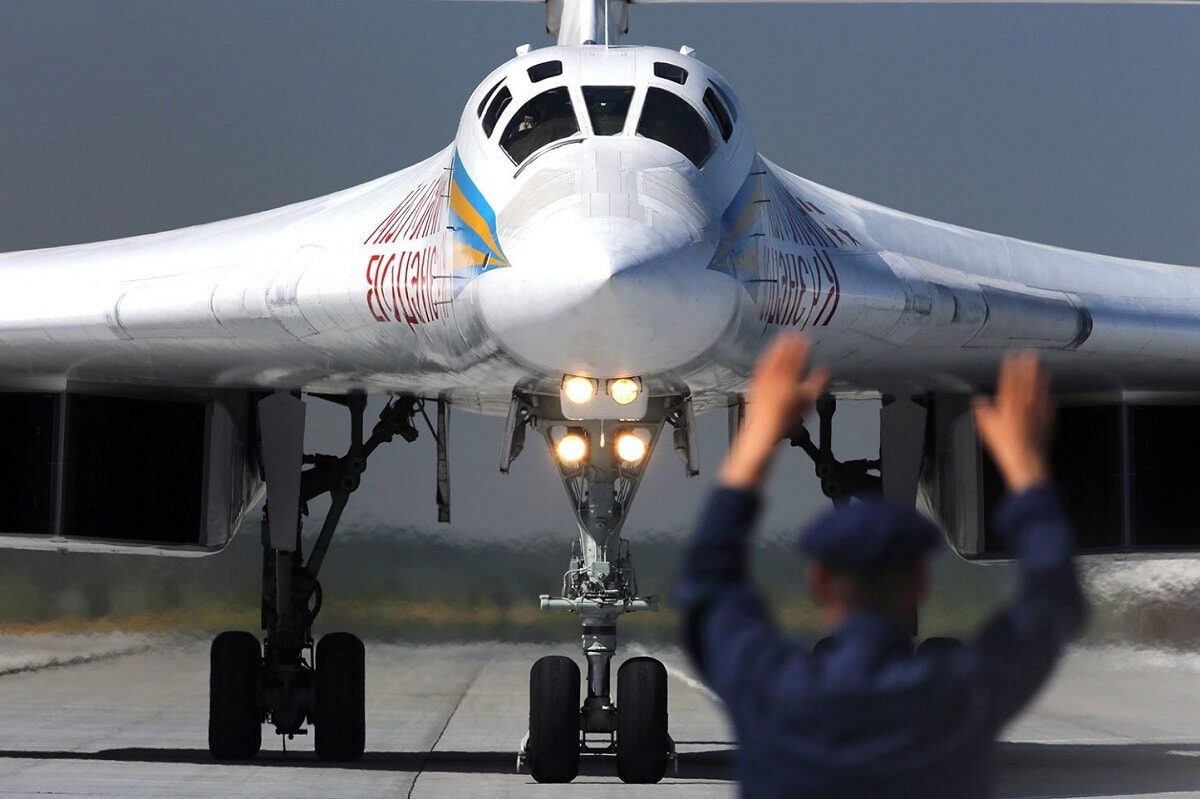The Tu-160 Could Do Some Serious Damage in Ukraine. Here’s Why: While Russia operates several different bomber models in active service, the Tu-160 sticks out as one of its most visually distinctive and capable. Known alternatively as the Blackjack by its NATO designation or the White Swan (Belyi Lebed’) by its Russian nickname, the Tu-160 is one of the most modern bombers in Russian service. Given its relatively young age and substantial upgrade potential, the Tu-160 will almost certainly remain in Russian service for years to come.
What is the White Swan Capable of?
Much of the distinctive shape of Russia’s Tu-160 is formed by its swept-back variable-geometry wings and its long, lean fuselage, which ends in an upturned point in the front of the aircraft. Four engines are spread across the aircraft’s wings, which in the most modern versions of the Blackjack are NK-32-02 engines. These powerful engines propel the White Swan with 55,000 pounds of thrust, giving the aircraft a max speed of Mach 2 with a range of 7,500 miles. With such capabilities, the Tu-160 can be equipped with 12 Kh-55MS cruise missiles or 24 Kh-15 air-launched ballistic missiles. Given the nuclear capability of Kh-55MS missiles, the Tu-160’s armament made it a critical part of the Soviet Union and Russia’s nuclear triads from the beginning of its existence.
Development of the Blackjack
Development on the original Tu-160 first began in 1972, and the aircraft’s first flight took place in late 1981. However, only 36 examples of the aircraft had been manufactured before construction was officially halted in 1994. Several Blackjacks which had been inherited by Ukraine were scrapped in the years following the collapse, and two examples of the aircraft which had been left incomplete on the assembly line in 1994 were completed by 2007. The 2015 decision to resume production of the White Swan was subsequently joined in April 2017 by the announcement that Russia’s Aerospace Forces would perform a deep modernization of all existing examples of the Tu-160. In addition to new engines, the Tu-160M, as the modernized version of the aircraft are known as (examples of the Blackjack produced in the most recent production series were initially known as Tu-160M2s), will also include upgraded avionics and a new anti-missile defensive system. Modernized Blackjacks are also reportedly capable of utilizing the more modern Kh-101 and Kh-102 cruise missiles.
An official order for 10 Tu-160s was made in January 2018, with the initial example of the order flying for the first time in January 2022. Russia’s Aerospace Forces have additionally expressed their desire to operate 50 total Blackjacks. Over the course of its restart of the Tu-160’s assembly lines, Russia’s United Aircraft Company (the state-owned aviation conglomerate which controls the Tupolev design bureau) was forced to contend with the challenge of restarting and reequipping an assembly line which had been inactive for more than 20 years.
Use of the Tu-160 in Ukraine
In what is certainly laced with a certain amount of irony, Russia has utilized its fleet of Tu-160s as part of its 2022 invasion of Ukraine, the only state other than Russia to have inherited and operated the White Swan after the collapse of the Soviet Union. Russian bombers such as the Tu-160 have been employed in a “stand-off” capacity as part of the invasion, preferring to fire their cruise missile payloads at targets in Ukraine while being well within Russian airspace themselves. Ukraine used to posses an entire regiment of Blackjacks in the immediate aftermath of the collapse of the Soviet Union and more examples of the aircraft than Russia. However, Ukraine did not have the resources to maintain a fleet of strategic bombers like the Tu-160, leading Kyiv to sell eight of its bombers to Russia and to scrap the rest.
While technological sanctions on Russia imposed before and after Moscow’s February 2022 invasion could present challenges to the continued future modernization of the Tu-160 in the medium- to long-term, much of the heavy lifting has already been done to restart production on the Blackjack. Regardless of headwinds, the recent movement to modernize Tu-160s indicates that Russia’s military leadership plans for the Tu-160 to be a critical element of its strategic bomber fleet in the future.
Wesley Culp is a Research Fellow at the Center for the Study of the Presidency and Congress. He regularly writes on Russian and Eurasian leadership and national security topics and has been published in The Hill as well as in the Diplomatic Courier. He can be found on Twitter @WesleyJCulp.

